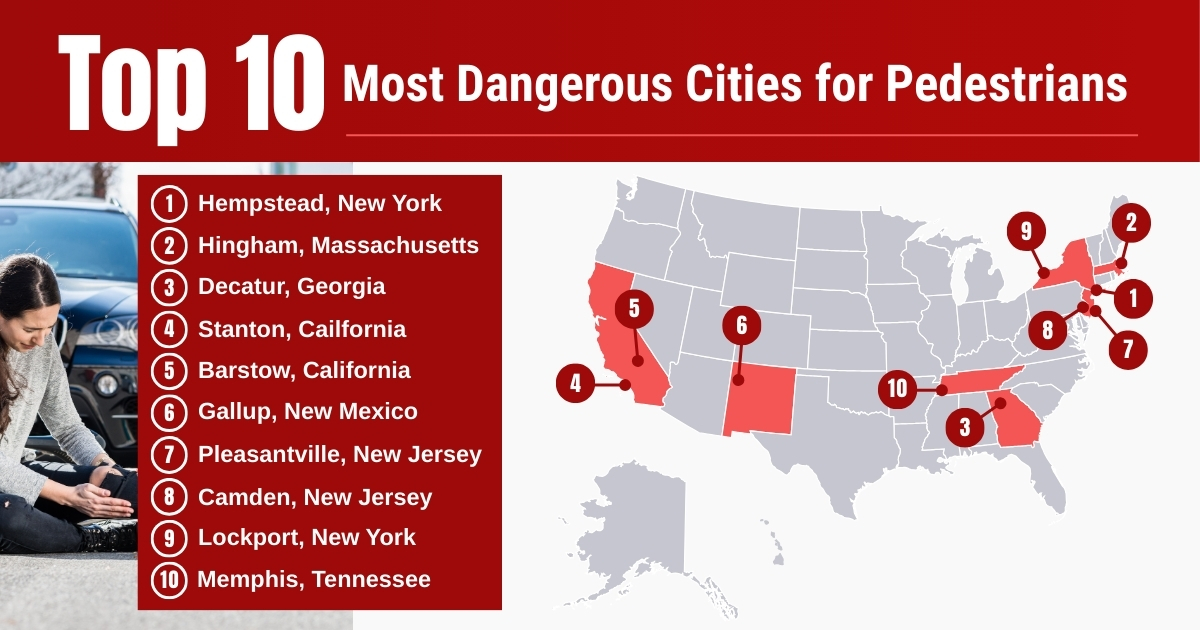For many Americans, walking isn’t just a healthy habit, it’s a daily commute or a quick trip to local shops. But for some, taking a stroll comes with serious risks. New data examining pedestrian accidents from 2020–2023 highlights where walking is most dangerous, where safety has improved, and which cities are seeing alarming spikes in incidents.
The Most Dangerous Cities
At the top of the danger scale is Hempstead, New York, with 117.5 pedestrian accidents per 100,000 residents over the three-year period. Following closely are Hingham, Massachusetts (94.2), Decatur, Georgia (73.5), Stanton, California (72.8), and Barstow, California (64.3). Other notable high-risk cities include Gallup, NM (63.9), Pleasantville, NJ (57.4), and Camden, NJ (55.7). Even Memphis, TN, rounds out the top ten with 50.7 accidents per 100,000 residents.

High accident rates often coincide with dense urban layouts, heavy traffic, and limited pedestrian infrastructure, making residents more vulnerable to collisions during peak travel times.
The Safest Cities
On the flip side, some cities have pedestrian accidents at almost negligible levels. San Diego, California tops the list of safest cities with only 0.14 accidents per 100,000 residents, followed by Guilford, North Carolina (0.18) and Los Angeles, California (0.18). San Francisco (0.36), Sacramento (0.37), and Macomb, Michigan (0.45) also rank among the safest.

These low numbers often reflect well-planned pedestrian infrastructure, safer crosswalks, slower traffic speeds, and effective traffic enforcement.
Emerging Hotspots: Cities With Rising Pedestrian Accidents
While some cities maintain safety, others are seeing alarming increases. Lincoln, Nebraska reported a 463.7% average yearly increase in pedestrian accidents; the highest in the nation. Other cities with notable spikes include Brownsville, TX (245.8%), Springfield, MA (224.3%), and Augusta, GA (215.0%).
These sharp rises may result from increased vehicle traffic, population growth, or insufficient pedestrian infrastructure, and they highlight the importance of proactive safety measures to protect residents.
Cities Making Progress
Conversely, some cities are showing promising improvements. Santa Rosa, CA, Prescott Valley, AZ, Teaneck, NJ, and Rockledge, FL all saw average yearly decreases of 62.5% in pedestrian accidents. Elk Grove, CA (-58.3%) and Sterling Heights, MI (-54.2%) also reported substantial declines, likely due to better crosswalks, public awareness campaigns, and traffic calming measures.
Why This Matters
Pedestrian accidents have serious consequences, from injuries and fatalities to long-term medical costs and legal disputes. Residents in high-risk areas face not only physical danger but also the stress of navigating unsafe streets. Firms like Maison Law provide crucial legal guidance for those involved in pedestrian accidents, helping victims navigate claims, insurance, and liability questions.
The data also underscores broader safety challenges: cities with rising accident rates need smarter urban planning, stricter traffic enforcement, and community education programs to reduce risks. Meanwhile, low-accident cities offer models for infrastructure improvements and pedestrian-friendly policies that could be replicated elsewhere.
Looking Ahead
Pedestrian safety is not static. Cities experiencing rising accident rates need urgent attention, while those with decreasing rates show that targeted interventions work. Measures like improved crosswalks, better lighting, dedicated bike lanes, and stricter enforcement against aggressive driving can make a tangible difference.
Methodology
Accident counts come from city and state level reports provided by the FHWA and pedestrian fatality counts were pulled from the NHTSA Fatality Analysis Reporting System (FARS). To calculate per-capita rates, we used population data from the U.S. Census Bureau. This approach ensures both the number of incidents and their impact relative to city size are accurately represented.
